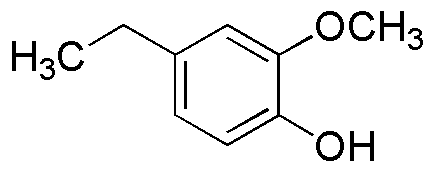4-Ethylguaiacol is widely utilized in research focused on:
- Flavor and Fragrance Industry: This compound is a key ingredient in the formulation of various food and beverage products, particularly in enhancing the aroma of smoked and grilled foods. Its pleasant, smoky scent is highly sought after in creating authentic flavors.
- Pharmaceutical Applications: It serves as a valuable intermediate in the synthesis of various pharmaceutical compounds, contributing to the development of medications that require specific aromatic properties.
- Biotechnology: Researchers use 4-Ethylguaiacol in studies related to microbial metabolism, helping to understand how certain microorganisms can break down aromatic compounds, which is crucial for bioremediation efforts.
- Cosmetics: The compound is incorporated into cosmetic formulations for its antioxidant properties, providing benefits in skin care products aimed at improving skin health and appearance.
- Aromatherapy: It is also used in the production of essential oils and aromatherapy products, where its unique scent can promote relaxation and enhance mood, making it popular in wellness applications.
General Information
Properties
Safety and Regulations
Applications
4-Ethylguaiacol is widely utilized in research focused on:
- Flavor and Fragrance Industry: This compound is a key ingredient in the formulation of various food and beverage products, particularly in enhancing the aroma of smoked and grilled foods. Its pleasant, smoky scent is highly sought after in creating authentic flavors.
- Pharmaceutical Applications: It serves as a valuable intermediate in the synthesis of various pharmaceutical compounds, contributing to the development of medications that require specific aromatic properties.
- Biotechnology: Researchers use 4-Ethylguaiacol in studies related to microbial metabolism, helping to understand how certain microorganisms can break down aromatic compounds, which is crucial for bioremediation efforts.
- Cosmetics: The compound is incorporated into cosmetic formulations for its antioxidant properties, providing benefits in skin care products aimed at improving skin health and appearance.
- Aromatherapy: It is also used in the production of essential oils and aromatherapy products, where its unique scent can promote relaxation and enhance mood, making it popular in wellness applications.
Documents
Safety Data Sheets (SDS)
The SDS provides comprehensive safety information on handling, storage, and disposal of the product.
Product Specification (PS)
The PS provides a comprehensive breakdown of the product’s properties, including chemical composition, physical state, purity, and storage requirements. It also details acceptable quality ranges and the product's intended applications.
Certificates of Analysis (COA)
Search for Certificates of Analysis (COA) by entering the products Lot Number. Lot and Batch Numbers can be found on a product’s label following the words ‘Lot’ or ‘Batch’.
*Catalog Number
*Lot Number
Certificates Of Origin (COO)
This COO confirms the country where the product was manufactured, and also details the materials and components used in it and whether it is derived from natural, synthetic, or other specific sources. This certificate may be required for customs, trade, and regulatory compliance.
*Catalog Number
*Lot Number
Safety Data Sheets (SDS)
The SDS provides comprehensive safety information on handling, storage, and disposal of the product.
DownloadProduct Specification (PS)
The PS provides a comprehensive breakdown of the product’s properties, including chemical composition, physical state, purity, and storage requirements. It also details acceptable quality ranges and the product's intended applications.
DownloadCertificates of Analysis (COA)
Search for Certificates of Analysis (COA) by entering the products Lot Number. Lot and Batch Numbers can be found on a product’s label following the words ‘Lot’ or ‘Batch’.
*Catalog Number
*Lot Number
Certificates Of Origin (COO)
This COO confirms the country where the product was manufactured, and also details the materials and components used in it and whether it is derived from natural, synthetic, or other specific sources. This certificate may be required for customs, trade, and regulatory compliance.

